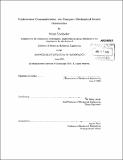| dc.contributor.advisor | H. Harry Asada. | en_US |
| dc.contributor.author | Ubellacker, Wyatt | en_US |
| dc.contributor.other | Massachusetts Institute of Technology. Department of Mechanical Engineering. | en_US |
| dc.date.accessioned | 2014-01-09T19:51:11Z | |
| dc.date.available | 2014-01-09T19:51:11Z | |
| dc.date.issued | 2013 | en_US |
| dc.identifier.uri | http://hdl.handle.net/1721.1/83751 | |
| dc.description | Thesis (S.B.)--Massachusetts Institute of Technology, Dept. of Mechanical Engineering, 2013. | en_US |
| dc.description | Cataloged from PDF version of thesis. | en_US |
| dc.description | Includes bibliographical references (page 55). | en_US |
| dc.description.abstract | Effective communication with underwater remotely operated vehicles (UROV) can be difficult to accomplish. In water, simple radio communication is quickly dissipated at higher frequencies and lower frequencies require a large antenna, which may not be practical in all applications. Light can also be used to communicate with the vehicles, but requires line of sight between the source and detector. Sound can also be used as a communication method, and has many advantages. It can propagate long distances underwater and does not require line of sight to work effectively. However, generating sound electronically underwater requires a large power speaker to produce tones loud enough to travel far distances. Generating sound mechanically can take advantage of physical resonance and produce high intensity tones in a compact device with a relatively low power input. This can allow for a compact, high intensity method to communicate with remotely operated underwater vehicles. | en_US |
| dc.description.statementofresponsibility | by Wyatt Ubellacker. | en_US |
| dc.format.extent | 55 pages | en_US |
| dc.language.iso | eng | en_US |
| dc.publisher | Massachusetts Institute of Technology | en_US |
| dc.rights | M.I.T. theses are protected by
copyright. They may be viewed from this source for any purpose, but
reproduction or distribution in any format is prohibited without written
permission. See provided URL for inquiries about permission. | en_US |
| dc.rights.uri | http://dspace.mit.edu/handle/1721.1/7582 | en_US |
| dc.subject | Mechanical Engineering. | en_US |
| dc.title | Underwater communication via compact mechanical sound generation | en_US |
| dc.type | Thesis | en_US |
| dc.description.degree | S.B. | en_US |
| dc.contributor.department | Massachusetts Institute of Technology. Department of Mechanical Engineering | |
| dc.identifier.oclc | 864756476 | en_US |
